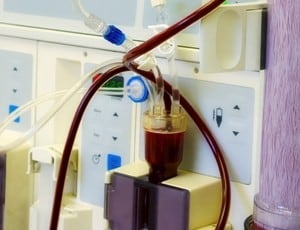What are the risk factors for CRBSI in neonates?

“We found that low birth weight and type of central venous catheter were associated with catheter-related bloodstream infection in neonates” Ferreira et al (2020).
Historical perspective on how public policy shaped dialysis care in the US

“This article recounts the historical background in which national coverage for dialysis care was developed, legislated and has evolved over the past 50 years” Anumudu and Eknoyan (2020).
Tunneled dialysis catheter exchange through fibrin sheath

“For patients with tunneled dialysis catheter dysfunction caused by fibrin sheath, catheter exchange through fibrin sheath crevice most likely is an safe and effective alternative strategy of the in-situ catheter exchange” Li et al (2020).
Inappropriateness of IV antibiotic prescriptions at hospital discharge

“Antimicrobial stewardship should be considered for intravenous antibiotics at hospital discharge to reduce the inappropriateness of those prescriptions” Mahatumarat et al (2019).
Minocycline-EDTA-Ethanol antimicrobial catheter lock solution

“We compared taurolidine and minocycline-EDTA-ethanol (MEE) catheter lock solutions in vitro for eradication of biofilm of 10 C. auris strains” Reitzel et al (2020).
Intraosseous access in adults in cardiac arrest

“To evaluate the efficacy of intraosseous access versus venous access in out-of-hospital cardiac arrest in terms of return of spontaneous circulation (ROSC) and survival to hospital discharge with or without favorable neurologic status” Morales-Cané et al (2020).
Prognostic factors and mortality associated with candidemia

“To study the epidemiology and to evaluate the risk factors, prognostic factors, and mortality associated with candidemia and to compare these findings with previously published studies from Saudi Arabia” Alkharashi et al (2019).
Pathogens causing central-line-associated bloodstream infections

“To describe pathogen distribution and rates for central-line-associated bloodstream infections (CLABSIs) from different acute-care locations during 2011-2017 to inform prevention efforts” Novosad et al (2020).
Optimal depth of central venous catheters in neonates

“The objective is to create a formula that predicts the optimal insertion depth of a real time ultrasound-guided CVC in the right internal jugular vein (RIJV) in newborns” Montes-Tapia et al (2019).
Previous PICC placement as a CLABSI risk factor

“The previous PICC placement was an independent risk factor for PICC-associated BSI and the risk proportionally rose with the increasing frequency of prior PICC placement” Kim et al (2020).
Current training in neonatal PICC placement

“To describe the current educational status of percutaneously inserted central catheter (PICC) insertion/ maintenance training for neonatal-perinatal medicine (NPM) fellows in the United States” Levit et al (2020).
Microbiome signatures in neonatal CLABSI

The blood microbiome in CLABSI neonates clustered separately from the uninfected blood samples in beta diversity plots. We found that the microbiome signature in catheter biofilm and blood of neonates with CLABSI is different than the microbiomes of non-CLABSI neonates” Pammi et al (2020).
Rapid and accurate bayesian diagnosis of heparin-induced thrombocytopenia

Prompt diagnostic work-up of suspected heparin-induced thrombocytopenia (HIT) is critical for guiding initial patient management” Marchetti et al (2020).
Clinical outcomes of teicoplanin use in the OPAT setting

We present a case series of patients undergoing OPAT care being treated by either teicoplanin-based (n = 107) or ceftriaxone-based (n = 191) antibiotic regimens” Dabrowski et al (2020).
Home infusion central line-associated bloodstream infection surveillance definition

Home infusion therapy and healthcare epidemiology experts developed candidate criteria for a home infusion CLABSI surveillance definition” Keller et al (2020).
How to undertake intravenous infusion calculations?

This article provides a step-wise, practical approach to undertaking intravenous (IV) infusion calculations” Brindley (2020).
Effects of transfusion on hemodynamic and oxygenation variables

The objectives of this study were, therefore, to evaluate, using systematic review and meta-analysis, the effects of transfusion on hemodynamic/oxygenation variables in patients without acute bleeding” Cavalcante dos Santos et al (2020).
Patient outcomes associated with repeat blood cultures

We examined factors associated with follow-up blood cultures (FU-BCs) in patients with monomicrobial gram-negative bloodstream infection (GN-BSI), and investigated impact of FU-BCs on therapeutic management and patient outcome” Giannella et al (2020).
TXA administration via IO and IM routes during hemorrhagic shock

TXA administration via IO and IM routes during hemorrhagic shock achieves serum concentrations necessary for inhibition of fibrinolysis and may be practical alternatives when IV access is not available” DeSoucy et al (2020).
What are the options for vascular access in cancer patients?

The most commonly used permanent venous access devices in cancer patients are the port, PICC port and PICC catheter (peripherally inserted central catheter)” Zapletal et al (2019). Abstract: The most commonly used permanent venous access devices in cancer patients are the port, PICC port and PICC catheter (peripherally inserted central catheter). It is always necessary […]
Hypodermoclysis for patients at end-of-life in home care settings

The increase in the elderly population associated with a higher incidence of cancer strongly endorses palliative care (PC). Hypodermoclysis (HDC) is a feasible technique for drugs and fluids delivery at the home care setting” Coelho et al (2020). Abstract: BACKGROUND: The increase in the elderly population associated with a higher incidence of cancer strongly endorses […]
Peripheral IV administration of high-risk infusions in critical care

In critical care, the short peripheral intravenous catheter is an essential venous access route, often used in emergency situations to administer high-risk medications and fluid resuscitation” Nickel (2019). Abstract: In critical care, the short peripheral intravenous catheter is an essential venous access route, often used in emergency situations to administer high-risk medications and fluid resuscitation. […]
Difficult guidewire insertion for central venous access

We describe the application of continuous image intensification to successfully identify the anatomical location and safe circumnavigation of guidewire obstruction during the insertion of a central venous and pulmonary artery catheter for cardiac surgery” Weinberg et al (2020). Abstract: PRESENTATION OF CASE: A 56-year old male presented for an elective redo-sternotomy, aortic valve replacement, tricuspid […]
MRSA and MSSA colonization in dialysis patients

MRSA and MSSA colonization in patients is associated with significant mortality and morbidity in dialysis patients” Price et al (2019). Abstract: Patients with end-stage renal disease are susceptible to infection, particularly methicillin-resistant Staphylococcus aureus (MRSA). Although MRSA-related mortality and morbidity have been studied, methicillin-sensitive Staphylococcus aureus (MSSA) has not been investigated to the same degree. […]
How to teat implantable port fibrin sheath formation?

Therefore, when a port malfunctions, thrombolytics are usually the only option attempted before the port is explanted and a new site is prepared for access. We present a minimally invasive technique demonstrating port salvage that does not require explant” Hagaman et al (2020). Abstract: Industry has long fought the battle to design a vascular catheter […]
Management of drug-induced peripherally inserted central catheter obstruction

The purpose of this research is to describe and understand nurses’ knowledge of drug-induced peripherally inserted central catheter obstruction management in developing countries” Zheng et al (2020). Abstract: OBJECTIVES: The purpose of this research is to describe and understand nurses’ knowledge of drug-induced peripherally inserted central catheter obstruction management in developing countries. This research aims […]
Is intravenous supplementation type associated with complications in chronic intestinal failure?

A 1-year international survey was carried out to investigate whether the European Society for Clinical Nutrition and Metabolism clinical classification of CIF, based on the type and volume of the intravenous supplementation (IVS), could be an indicator of CIF severity” Pironi et al (2020). Abstract: BACKGROUND AND AIM: No marker to categorise the severity of […]
Extravasation of peripheral norepinephrine in the emergency department

…Emergency Department (ED) implemented a protocol that recommends peripheral norepinephrine (pNE) be administered through an 18 gauge or larger at or above the antecubital fossa or the external jugular vein with a maximum dose of 20 μg/min” Nguyen et al (2020). Abstract OBJECTIVE: Vasopressors are typically administered through central venous catheters (CVC) due to a […]
Blood loss and anemia from laboratory testing

Blood loss for laboratory testing is substantial in ICU patients and significantly associated with RBC transfusion” Jackson Chornenki et al (2019). Abstract: BACKGROUND: Anemia is common in critically ill patients and associated with adverse outcomes. Phlebotomy associated with laboratory testing is a potentially modifiable contributor. This study aims to 1) characterize the blood volume taken […]
Ultralong versus standard long peripheral intravenous catheters

This study demonstrated increased catheter survival when the ultralong compared with the standard long ultrasonographically guided intravenous peripheral catheter was used” Bahl et al (2020). Abstract: STUDY OBJECTIVE: Ultrasonographically guided intravenous peripheral catheters have dismal dwell time, with most intravenous lines failing before completion of therapy. Catheter length in the vein is directly related to […]

